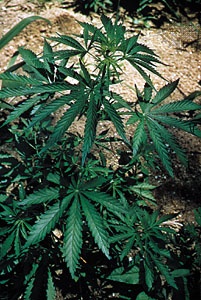marijuana
drug
also spelled marihuana
 the Indian hemp plant, Cannabis sativa ( Cannabis), or the crude drug composed of its leaves and flowers. It is usually dried and crushed and put into pipes or formed into cigarettes (joints) for smoking. The drug—known by a variety of other names, including pot, tea, grass, and weed—can also be added to foods and beverages. Marijuana varies in potency, depending on where and how it is grown, prepared for use, or stored. The active ingredient, tetrahydrocannabinol (THC), is present in all parts of both the male and female plants but is most concentrated in the resin (cannabin) in the flowering tops of the female. hashish, a more powerful form of the drug, is made by collecting and drying this resin and is about eight times as strong as the marijuana typically smoked in the United States.
the Indian hemp plant, Cannabis sativa ( Cannabis), or the crude drug composed of its leaves and flowers. It is usually dried and crushed and put into pipes or formed into cigarettes (joints) for smoking. The drug—known by a variety of other names, including pot, tea, grass, and weed—can also be added to foods and beverages. Marijuana varies in potency, depending on where and how it is grown, prepared for use, or stored. The active ingredient, tetrahydrocannabinol (THC), is present in all parts of both the male and female plants but is most concentrated in the resin (cannabin) in the flowering tops of the female. hashish, a more powerful form of the drug, is made by collecting and drying this resin and is about eight times as strong as the marijuana typically smoked in the United States.Mentioned in a Chinese herbal dating from 2700 BC, marijuana has long been considered valuable as an analgesic, an anesthetic, an antidepressant, an antibiotic, and a sedative. Although it was usually used externally (e.g., as a balm or smoked), in the 19th century its tips were sometimes administered internally to treat gonorrhea and angina pectoris. Marijuana's effects vary, depending upon the strength and amount consumed, the setting in which it is taken, and the experience of the user. Psychological effects tend to predominate, with the user commonly experiencing a mild euphoria. Alterations in vision and judgment result in distortions of time and space. Acute intoxication may occasionally induce visual hallucinations, anxiety, depression, extreme variability of mood, paranoid reactions, and psychoses lasting from four to six hours. Marijuana's physical effects include reddening of the eyes, dryness of the mouth and throat, moderate increase in the rapidity of the heartbeat, tightness of the chest (if the drug is smoked), drowsiness, unsteadiness, and muscular incoordination. Chronic use does not establish physical dependence, nor does the regular user suffer extreme physical discomfort after withdrawal. However, the use of marijuana may be psychologically habituating.
The worldwide use of marijuana and hashish as intoxicants has raised various medical and social questions, many of which have been under continuing scientific investigation, especially since the mid-1960s, when THC was first isolated and produced synthetically. Research was directed toward identifying the short- and long-term physical effects of marijuana. In the late 20th century, medical research revealed various therapeutic effects of marijuana and THC. They were found to be useful in lowering internal eye pressure in persons suffering from glaucoma and in alleviating nausea and vomiting caused by chemotherapeutic (chemotherapy) drugs used to treat cancer patients and those with AIDS. Marijuana also has been found to reduce the muscle pain associated with multiple sclerosis and to prevent epileptic seizures in some patients. In the late 1980s researchers discovered a receptor for THC and THC-related chemicals in the brains of certain mammals, including humans. This finding indicated that the brain naturally produces a THC-like substance that may perform some of the same functions that THC does. Such a substance subsequently was found and named anandamide, from the Sanskrit anada (“bliss”).
International trade in marijuana and hashish was first placed under controls during the International Opium Convention of 1925. By the late 1960s most countries had enforced restrictions on trafficking and using marijuana and hashish and had imposed generally severe penalties for their illegal possession, sale, or supply. Beginning in the 1970s some countries and jurisdictions reduced the penalty for the possession of small quantities. The Netherlands has long tolerated the sale of small amounts of marijuana, and in 1999 its legislature debated the decriminalization of the drug. In 1998 Swiss voters overwhelmingly rejected a broad referendum that would have legalized many drugs, including marijuana, heroin, and cocaine, but the government took steps to legalize marijuana two years later. Other European countries also began debating the decriminalization of so-called “soft drugs,” including marijuana.
In the United States, several states passed legislation in the late 1970s and early '80s to fund research on or to legalize the medicinal use of marijuana, though some of these statutes were later repealed or lapsed. Renewed decriminalization efforts in the 1990s led to the legalization of medicinal marijuana in Alaska, Arizona, California, Colorado, Nevada, Oregon, and Washington. In 2001, however, the U.S. Supreme Court ruled against the use of marijuana for medical purposes. Later that year Canada passed legislation easing restrictions on medicinal marijuana. The country's new regulations included licensing marijuana growers to produce the drug for individuals with terminal illnesses or chronic diseases.
- Mantle, Mickey
- Manto
- mantra
- Mantua
- Mantua, Siege of
- Manu
- Manuae Atoll
- Manua Islands
- Manual of Discipline
- manucode
- Manuela Di Centa
- Manuel Antônio de Almeida
- Manuel A. Odría
- Manuela Sáenz
- Manuel Azaña y Díaz
- Manuel Bandeira
- Manuel Belgrano
- Manuel Bretón de los Herreros
- Manuel Bulnes
- Manuel Ceferino Oribe
- Manuel Chrysoloras
- Manuel da Fonseca
- Manuel da Nóbrega
- Manuel de Falla
- Manuel de Godoy